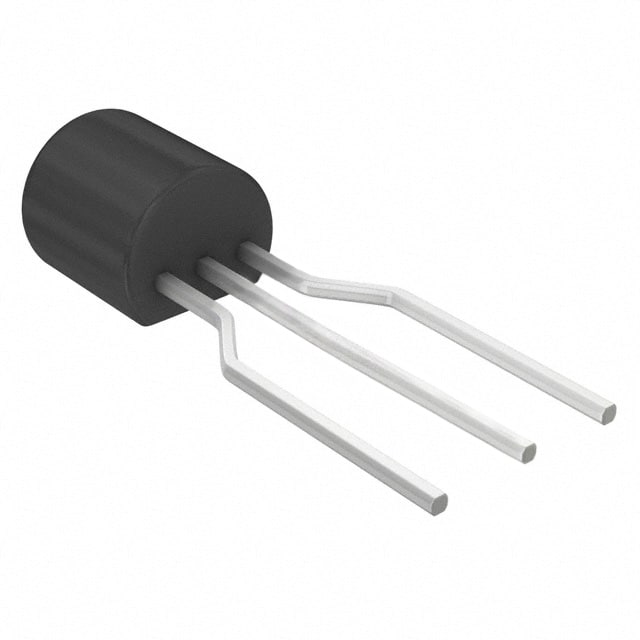Consulte las especificaciones para obtener detalles del producto.

BC549TF Transistor
Product Category
The BC549TF transistor belongs to the category of small-signal NPN bipolar junction transistors.
Basic Information Overview
- Use: The BC549TF transistor is commonly used for amplification and switching purposes in electronic circuits.
- Characteristics: It exhibits low noise, high current gain, and low power dissipation characteristics.
- Package: The BC549TF transistor is typically available in a TO-92 package.
- Essence: This transistor is essential for signal amplification and switching applications in various electronic devices.
- Packaging/Quantity: It is usually packaged in reels or tubes containing a specific quantity per package.
Specifications
The BC549TF transistor has the following specifications: - Maximum Collector-Emitter Voltage: 30V - Maximum Collector Current: 100mA - DC Current Gain (hFE) Range: 110-800 - Power Dissipation: 500mW
Detailed Pin Configuration
The BC549TF transistor has three pins: 1. Emitter (E): This pin is connected to the N-type material and is the source of electrons. 2. Base (B): The middle pin that controls the flow of current between the collector and emitter. 3. Collector (C): This pin collects the majority charge carriers, making it the output terminal.
Functional Features
The BC549TF transistor offers the following functional features: - High current gain for amplification purposes. - Low noise performance, making it suitable for signal processing applications. - Reliable switching capabilities for digital circuits.
Advantages and Disadvantages
Advantages
- High current gain allows for efficient signal amplification.
- Low noise characteristics make it suitable for audio applications.
- Compact TO-92 package enables easy integration into circuit designs.
Disadvantages
- Limited maximum collector current compared to other transistors.
- Relatively lower voltage handling capability.
Working Principles
The BC549TF transistor operates based on the principles of bipolar junction transistors. When a small current flows into the base terminal, it controls a larger current flowing between the collector and emitter terminals, allowing for amplification or switching of signals.
Detailed Application Field Plans
The BC549TF transistor finds extensive use in the following application fields: - Audio Amplification: Due to its low noise characteristics, it is widely used in audio amplifier circuits. - Signal Processing: Its high current gain makes it suitable for various signal processing applications. - Switching Circuits: The transistor's switching capabilities are utilized in digital logic circuits.
Detailed and Complete Alternative Models
Some alternative models to the BC549TF transistor include: - 2N3904 - BC547 - 2N2222
In conclusion, the BC549TF transistor is a versatile component with applications in amplification, signal processing, and switching circuits. Its compact size, low noise characteristics, and high current gain make it a popular choice for various electronic designs.
[Word Count: 386]
Enumere 10 preguntas y respuestas comunes relacionadas con la aplicación de BC549TF en soluciones técnicas
What is the BC549TF transistor used for?
- The BC549TF transistor is commonly used for general purpose amplification and switching applications in electronic circuits.
What are the key specifications of the BC549TF transistor?
- The BC549TF transistor typically has a maximum collector current of 100mA, a maximum collector-emitter voltage of 30V, and a maximum power dissipation of 500mW.
Can the BC549TF be used as a switch?
- Yes, the BC549TF can be used as a switch in low-power applications due to its ability to control larger currents and voltages with a small input signal.
How do I identify the pinout of the BC549TF transistor?
- The pinout of the BC549TF transistor is typically Emitter (E), Base (B), and Collector (C). When viewing the flat side with the pins down, the left pin is the emitter, the middle pin is the base, and the right pin is the collector.
What are some common circuit configurations using the BC549TF transistor?
- Common circuit configurations include common emitter amplifiers, switch circuits, and oscillator circuits.
What are the typical operating conditions for the BC549TF transistor?
- The BC549TF transistor is typically operated within a temperature range of -65°C to 150°C and is suitable for use in low to medium frequency applications.
Can the BC549TF be used in audio amplifier circuits?
- Yes, the BC549TF can be used in low-power audio amplifier circuits due to its general-purpose amplification capabilities.
What are some alternative transistors to the BC549TF?
- Alternative transistors that can be used in place of the BC549TF include the BC547, BC548, and 2N3904 transistors.
Are there any special considerations when soldering the BC549TF transistor?
- It is important to avoid excessive heat when soldering the BC549TF transistor to prevent damage to the component. Additionally, proper static discharge precautions should be taken.
Where can I find detailed datasheets and application notes for the BC549TF transistor?
- Detailed datasheets and application notes for the BC549TF transistor can be found on the websites of semiconductor manufacturers or distributors, such as ON Semiconductor or STMicroelectronics.

